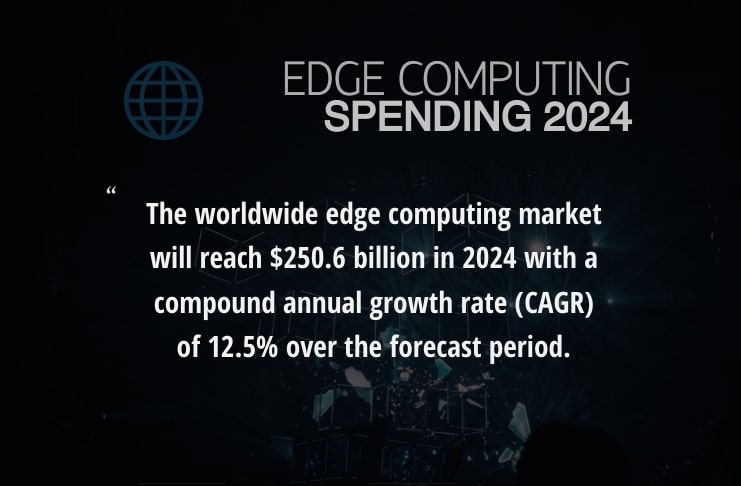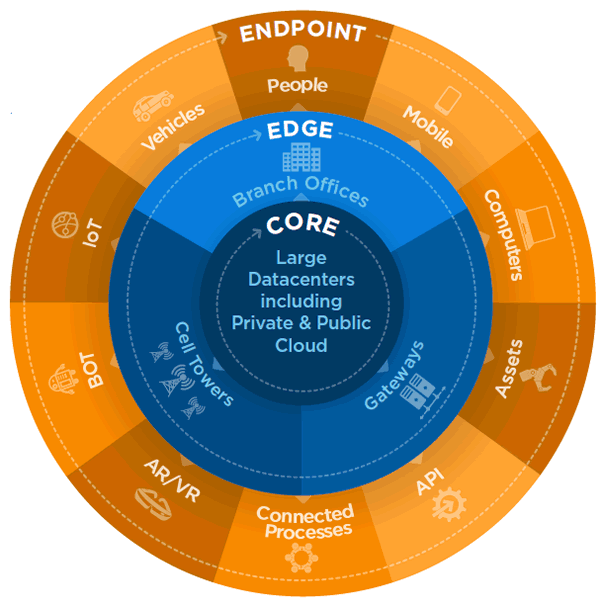As we enter the so-called era of distributed intelligence, worldwide spending on edge computing is expected to reach a total of $250 Billion in 2024. An overview and additional information.
According to a Spending Guide by IDC (International Data Corporation), throughout the next few years, edge computing spending will be led by a future of ‘extraordinary value and opportunity.’ Spending will mainly be concentrated in the US and Western Europe with the Americas, the EMEA region, and Asia/Pacific today already accounting for around 99 percent of the total.

With a compound annual growth rate of 12.5 percent during the forecast period and a predicted worldwide edge spend of $250 Billion in 2024, edge computing is rising fast while cloud becomes the new core, as IDC predicted previously in its ‘Data Age’ report.
These shifts are in line with what has been happening in the market for several years and the evolution of the (impact of the ) global – continuously growing – datasphere whereby more use cases demand real-time processing for an increasing percentage of data.
They go hand in hand with the shift of intelligence to the edge in IoT (for instance, in building system integration and building management evolutions), data center shifts, and newer technologies, including mobile networks (5G), and future applications, i.a. in automotive. Industry 4.0 is a crucial driver of edge spending, with manufacturing ranking high in the list of industries spending most on edge computing (see some benefits of edge in smart manufacturing).
As a reminder, edge computing is essentially a distributed computing paradigm whereby processing happens closer to the source (endpoint). It comprises infrastructure, software, and services between data centers and these ‘intelligent’ endpoints, enabling to leverage an increasing variety of devices for more robust and efficient digital transformation purposes.
For Dave McCarthy, research director, Edge Strategies at IDC, edge products and services are even powering the next wave of digital transformation. McCarthy: “With the ability to place infrastructure and applications close to where data is generated and consumed, organizations of all types are looking to edge technology as a method of improving business agility and creating new customer experiences.”
Looking at the illustration from IDC and Seagate’s 2018 ‘Data Age 2025’ report below, you can say that the essential capabilities for compute, storage, network, and data creation/analysis are outside the core.

This shift to a more distributed environment with the endpoints playing a more important role isn’t new and goes hand in hand with endpoints (mobile devices, connected assets, vehicles, etc.) being the main locations for data creation.
Edge spending – industries and technologies
In its edge spending update, IDC also looks at the main growth areas for edge computing. From an industry perspective, manufacturing leads: the top three industries for edge spending throughout the forecast period are 1) discrete manufacturing, 2) professional services, and 3) process manufacturing.
“Edge products and services are powering the next wave of digital transformation. With the ability to place infrastructure and applications close to where data is generated and consumed, organizations of all types are looking to edge technology as a method of improving business agility and creating new customer experiences.” (Dave McCarthy, research director, Edge Strategies at IDC)
Retail is another vital industry, as among others explained in our article on retail facilities. In fact, according to IDC, retail is expected to overtake process manufacturing and rank third from a spending perspective by the end of the forecast period (2024). However, the fastest growth over the forecast period is for professional services (edge spending increase with a five-year CAGR of 15.4 percent).
Looking at edge spending from the technology perspective, IDC expects that services (including professional and provisioned services) will account for almost half (46.2 percent) of all edge spending in 2024. Hardware ranks second with a 32.2 percent edge spending share, and software third with 21.6 percent poised to go to edge-related software.”

